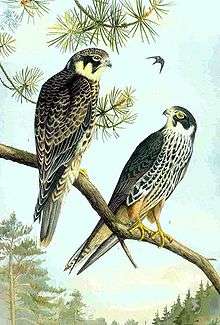Hobby (bird)
| Hobbies | |
|---|---|
 | |
| Eurasian hobby (Falco subbuteo) showing the typical color pattern | |
| Scientific classification | |
| Kingdom: | Animalia |
| Phylum: | Chordata |
| Class: | Aves |
| Order: | Falconiformes |
| Family: | Falconidae |
| Genus: | Falco |
| Subgenus: | Hypotriorchis Boie, 1826 |
| Species | |
|
6-9, see text. | |
A hobby is a fairly small, very swift falcon with long, narrow wings. Four birds called "hobby", and some others which, although termed "falcon", are very similar. All specialise in being superb aerialists. Although they take prey on the ground if the opportunity presents itself, most prey is caught on the wing; insects are often caught by hawking, and many different birds are caught in flight, where even the quick maneuvering swifts and swallows cannot escape a hobby.
The typical hobbies are traditionally considered a subgenus, Hypotriorchis, due to their similar morphology; they have ample amounts of dark slaty grey in their plumage; the malar area is black; and the underside usually has lengthwise black streaks. The tails are all-dark or have only slight bands.[1]
Monophyly of Hypotriorchis is supported by DNA sequence data, though the exact limits of the group are still uncertain. The hobbies seem to be one of the Falco lineages which emerged around the Miocene-Pliocene boundary some 8-5 million years ago and subsequently radiated - in this case throughout the Old World. Their relationship to the peregrine falcon group and the kestrels is not well resolved, however; taxa such as the red-footed falcon appear in some respects intermediate between the kestrels and the typical hobbies.[2][3][4][5]
- Eurasian hobby (F. subbuteo), also known as the northern hobby
- African hobby (F. cuvierii)
- Oriental hobby (F. severus)
- Australian hobby or little falcon (F. longipennis), uncommon but widespread in Australia, during the southern winter, some birds migrate to the north of the continent or to the islands of Southeast Asia
- Sooty falcon (F. concolor) of the North African desert
- Eleonora's falcon (F. eleonorae) occupies the Mediterranean area during the northern summer, and migrates south to Madagascar for the southern summer.
These species are tentatively placed here:
- New Zealand falcon or kārearea (F. novaeseelandiae).
- Brown falcon (F. berigora)
- Taita falcon (F. fasciinucha)
References
- ↑ White, Clayton M.; Olsen, Penny D. & Kiff, Lloyd F. (1994): Family Falconidae. In: del Hoyo, Josep; Elliott, Andrew & Sargatal, Jordi (editors): Handbook of Birds of the World, Volume 2 (New World Vultures to Guineafowl): 216-275, plates 24-28. Lynx Edicions, Barcelona. ISBN 84-87334-15-6
- ↑ Helbig, A.J.; Seibold, I.; Bednarek, W.; Brüning, H.; Gaucher, P.; Ristow, D.; Scharlau, W.; Schmidl, D. & Wink, Michael (1994): Phylogenetic relationships among falcon species (genus Falco) according to DNA sequence variation of the cytochrome b gene. In: Meyburg, B.-U. & Chancellor, R.D. (editors): Raptor conservation today: 593-599. PDF fulltext
- ↑ Wink, Michael; Seibold, I.; Lotfikhah, F. & Bednarek, W. (1998): Molecular systematics of holarctic raptors (Order Falconiformes). In: Chancellor, R.D., Meyburg, B.-U. & Ferrero, J.J. (editors): Holarctic Birds of Prey: 29-48. Adenex & WWGBP. PDF fulltext
- ↑ Groombridge, Jim J.; Jones, Carl G.; Bayes, Michelle K.; van Zyl, Anthony J.; Carrillo, José; Nichols, Richard A. & Bruford, Michael W. (2002): A molecular phylogeny of African kestrels with reference to divergence across the Indian Ocean. Molecular Phylogenetics and Evolution 25(2): 267–277. doi:10.1016/S1055-7903(02)00254-3 (HTML abstract)
- ↑ Nittinger, F.; Haring, E.; Pinsker, W.; Wink, Michael & Gamauf, A. (2005): Out of Africa? Phylogenetic relationships between Falco biarmicus and other hierofalcons (Aves Falconidae). Journal of Zoological Systematics and Evolutionary Research 43(4): 321-331. doi:10.1111/j.1439-0469.2005.00326.x PDF fulltext